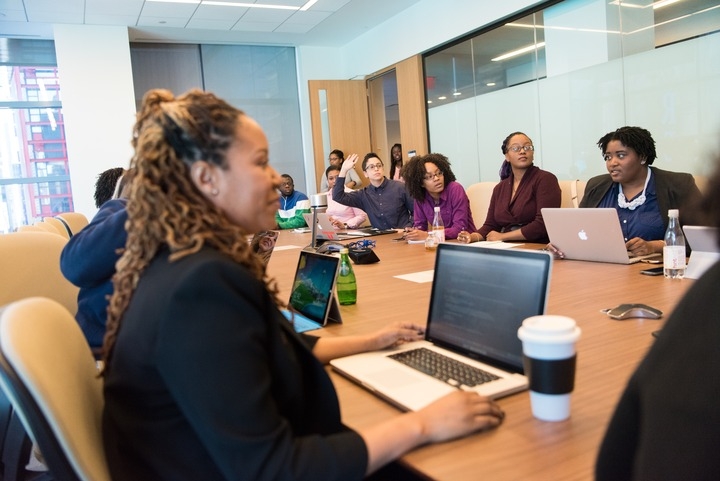
Table of Contents
Effective communication skills for trainers are the cornerstone of success and fulfillment in this profession. As a trainer, the ability to connect with learners on an emotional level fills me with a sense of purpose and satisfaction. I believe that communication is not just about transmitting information but also about creating meaningful connections, fostering understanding, and inspiring growth. One key strategy for effective communication as a trainer is active listening. It fills me with genuine empathy and curiosity to listen attentively to the needs and concerns of my learners. By truly understanding their perspectives and challenges, I can tailor my communication to meet their specific needs, building trust and rapport along the way. Nonverbal communication is another powerful tool that evokes strong emotions. Expressing enthusiasm and passion through body language, facial expressions, and gestures creates an atmosphere of energy and engagement. It allows me to connect with learners on a deeper level, inspiring them to actively participate and embrace the learning experience. Using clear and concise language in my communication fills me with a sense of clarity and effectiveness. I strive to communicate complex concepts in a way that is easily understood, breaking them down into digestible pieces. This clarity empowers learners and instills in them a sense of confidence and competence.

Creating a safe and inclusive learning environment is a priority that evokes a sense of compassion and empathy in me. I value diversity and ensure that my communication respects and appreciates different perspectives and backgrounds. By fostering an atmosphere of trust and respect, I create space for open dialogue and meaningful interactions among learners. Adapting my communication style to the unique needs of each learner fills me with a deep sense of connection and understanding. Some learners may prefer visual aids, while others may respond better to interactive activities. By flexibly adjusting my approach, I ensure that every learner feels heard, valued, and supported. Using storytelling and real-life examples in my communication allows me to connect with learners emotionally. Sharing personal experiences and anecdotes creates a sense of relatability and relevance, making the content more memorable and meaningful. It brings me joy to see the spark of recognition and inspiration in the eyes of my learners as they connect with the stories shared. Feedback and open communication are vital aspects of effective training. It fills me with satisfaction and pride to provide constructive feedback to learners, guiding them towards improvement and growth. Additionally, I encourage open dialogue, allowing learners to express their thoughts, concerns, and questions. This two-way communication fosters collaboration and strengthens the learning experience.
Embracing technology as a communication tool excites me, as it opens up a world of possibilities. From virtual classrooms to online forums, I leverage digital platforms to engage learners, encourage collaboration, and facilitate communication beyond traditional boundaries. The opportunity to connect with learners from different parts of the world fills me with a sense of wonder and excitement. Effective communication skills for trainers are not just about transmitting information; they are about building connections, inspiring growth, and creating transformative learning experiences. The ability to communicate effectively fills me with a deep sense of purpose and fulfillment as I empower learners to reach their full potential. By employing key strategies such as active listening, nonverbal communication, clarity, inclusivity, adaptability, storytelling, feedback, and technology, I strive to create an environment where learners thrive and communication becomes a catalyst for personal and professional development. Effective communication skills are the lifeblood of a successful trainer, and they ignite a fire of passion within me. As I stand in front of a group of learners, the ability to convey my knowledge and expertise with clarity, empathy, and enthusiasm fills me with a sense of purpose and excitement. One key strategy for effective communication as a trainer is the use of visual aids. Incorporating engaging visuals such as charts, graphs, and diagrams not only captures learners’ attention but also sparks their curiosity. Seeing their eyes light up with understanding and witnessing their eagerness to learn fills me with a deep sense of satisfaction and joy.
Another essential strategy is the power of storytelling. Sharing personal anecdotes, real-life examples, and case studies adds an emotional element to the learning experience. It allows me to connect with learners on a deeper level and enables them to see the practical applications of the concepts being taught. The impact of a well-told story, where learners can relate and empathize, fills me with a sense of fulfillment and accomplishment. Active engagement is a cornerstone of effective communication. Encouraging discussions, group activities, and hands-on exercises creates an interactive learning environment. It fills me with excitement to witness the energy and enthusiasm in the room as learners actively participate and contribute their thoughts and ideas. The sense of collaboration and shared learning is truly rewarding. Flexibility in communication is also crucial. Adapting my communication style to meet the needs and preferences of different learners allows me to connect with them on an individual level. Whether it’s adjusting the pace of delivery, using various modes of communication, or providing alternative explanations, the ability to adapt fills me with a sense of versatility and satisfaction as I witness learners’ increased engagement and understanding. Empathy plays a vital role in effective communication as a trainer. Understanding the unique challenges, fears, and aspirations of each learner allows me to tailor my communication to their specific needs. The ability to empathize and create a safe and supportive learning environment fills me with a deep sense of compassion and connection.
Active listening is another crucial skill. By truly hearing and understanding the questions, concerns, and feedback of learners, I can address their needs more effectively. Witnessing their appreciation for being heard fills me with a sense of fulfillment and reaffirms the value of attentive and empathetic listening. Lastly, clarity in communication is paramount. Breaking down complex concepts into simple, digestible pieces fills me with a sense of accomplishment. Seeing the lightbulb moments on the faces of learners as they grasp challenging concepts energizes me and motivates me to continue refining my communication skills. Effective communication skills for trainers go beyond conveying information. They ignite a spark of inspiration, foster engagement, and create an environment where learners feel supported and motivated. The ability to communicate with clarity, empathy, and enthusiasm fills me with a profound sense of purpose and fulfillment as I empower learners to unlock their full potential and succeed on their learning journey.
Verbal communication lies at the heart of effective training. As trainers, our ability to articulate ideas, engage participants, and create meaningful learning experiences heavily relies on our verbal communication skills. Mastering the art of verbal communication elevates our training sessions to new heights, fostering connection, comprehension, and emotional engagement. In this article, we will explore essential tips for trainers to enhance their verbal communication skills with passion and emotion.

Clarity and Simplicity: When delivering information, clarity is paramount. Express ideas in a concise and straightforward manner, using simple language that is accessible to all participants. Avoid jargon or technical terms that may confuse or alienate learners. Clear and simple communication promotes understanding, allowing participants to grasp concepts and apply them effectively. Engaging Delivery: Engage participants through dynamic and varied delivery techniques. Vary your tone, pace, and volume to maintain interest and capture attention. Use vocal inflections to emphasize key points and create emotional impact. Incorporate storytelling, humor, and real-life examples to make the content relatable and memorable. Active Listening: Effective communication is a two-way process. Practice active listening by genuinely paying attention to participants’ questions, comments, and concerns. Engage in meaningful dialogue, demonstrating respect and empathy. Active listening builds rapport, encourages participation, and creates a collaborative learning environment. Non-Verbal Communication: Non-verbal cues, such as facial expressions, gestures, and body language, complement verbal communication. Be mindful of your non-verbal signals, as they convey emotions and attitudes. Maintain eye contact to establish connection and show attentiveness. Use appropriate gestures to reinforce key points. Non-verbal communication adds depth and emotional resonance to your verbal messages. Empathy and Emotional Connection: Empathy is a powerful tool in training. Show genuine care and understanding for participants’ challenges and aspirations. Connect with their emotions by sharing personal anecdotes, demonstrating vulnerability, and acknowledging their progress. Emotional connection enhances engagement, trust, and motivation, creating an environment conducive to meaningful learning experiences.
Encourage Questions and Discussion: Promote active participation by encouraging questions and facilitating discussion. Create a safe space where participants feel comfortable sharing their thoughts and seeking clarification. Respond to questions with patience and respect, ensuring that everyone’s voice is heard. Discussion fosters deeper understanding, critical thinking, and emotional engagement. Tailor Communication to the Audience: Adapt your communication style to suit the needs and preferences of your audience. Consider factors such as language proficiency, cultural backgrounds, and learning styles. Speak at a pace that allows participants to follow along comfortably. Use examples and analogies that resonate with their experiences. Tailoring your communication builds connection and enhances comprehension. Use Visual Aids Effectively: Visual aids can enhance your verbal communication and reinforce key messages. Utilize slides, charts, or props to complement your verbal explanations. Keep visual aids simple, uncluttered, and visually appealing. Use appropriate colors and fonts that are easy to read. Visual aids help participants visualize concepts and aid memory retention.
Provide Constructive Feedback: Feedback is an essential component of effective communication in training. Provide constructive feedback that is specific, actionable, and supportive. Recognize participants’ strengths and areas for improvement. Offer praise and encouragement, helping them build confidence and motivation. Constructive feedback fuels growth and enhances the learning experience. Practice, Reflect, and Improve: Verbal communication is a skill that can be honed through practice and reflection. Record and review your training sessions to identify areas for improvement. Seek feedback from participants and colleagues to gain different perspectives. Continuously work on refining your delivery, language, and engagement techniques. With dedication and self-reflection, you can continuously improve your verbal communication skills as a trainer.
Mastering the art of verbal communication is vital for trainers to create impactful learning experiences. Through clarity, engaging delivery, active listening, empathy, tailored communication, effective use of visual aids, and providing constructive feedback, trainers can foster comprehension, emotional connection, and active participation. By continuously practicing and refining their verbal communication skills, trainers elevate their training sessions to new heights, leaving a lasting impact on participants’ growth and development. Let us embrace the art of verbal communication, infusing our training with passion and emotion, as we empower learners to reach their full potential.
Nonverbal communication is a powerful tool that trainers can harness to enhance the impact of their training sessions. Through the effective use of nonverbal cues, trainers evoke emotions of understanding, connection, and a deep engagement with the training content. Let’s explore the significance of nonverbal communication in training and how it can elevate the overall training experience. Firstly, body language plays a crucial role in conveying messages and establishing rapport with participants. By using open and welcoming gestures, maintaining eye contact, and adopting a confident posture, trainers evoke emotions of trust, attentiveness, and a desire for connection. Positive body language creates an inviting and approachable environment, fostering a sense of comfort and engagement among participants. Facial expressions are another essential aspect of nonverbal communication. By displaying genuine smiles, expressions of empathy, and enthusiasm, trainers evoke emotions of warmth, authenticity, and a desire for shared learning. Facial expressions serve as a visual representation of trainers’ emotions, helping to convey messages and elicit emotional responses from participants.

Gestures and hand movements can enhance trainers’ ability to illustrate concepts, emphasize key points, and engage participants. By using purposeful gestures, trainers evoke emotions of clarity, emphasis, and a desire for visual understanding. Well-executed gestures create a visual connection between trainers and participants, enhancing comprehension and retention of information. Proxemics, or the use of personal space, also influences training dynamics. Trainers who strike the right balance between being approachable and respecting participants’ personal space evoke emotions of comfort, respect, and a desire for collaboration. Effective use of proxemics ensures that participants feel physically and emotionally engaged in the training process. Voice modulation and tone are powerful nonverbal communication tools that can captivate participants’ attention and evoke emotions. By varying the pitch, volume, and pace of speech, trainers can convey enthusiasm, emphasis, and a desire for impact. A well-modulated voice captures participants’ interest, adds depth to the training content, and creates a memorable learning experience.
Eye contact is a critical nonverbal cue that establishes a connection between trainers and participants. By maintaining regular eye contact, trainers evoke emotions of attentiveness, credibility, and a desire for active participation. Eye contact fosters a sense of connection and validates participants’ presence, promoting engagement and ensuring that the training message is received effectively. Personal appearance and attire also contribute to nonverbal communication. By dressing professionally and appropriately, trainers evoke emotions of credibility, respect, and a desire for professionalism. Well-groomed trainers create a positive impression and convey a sense of professionalism that enhances the overall training experience. The use of props and visual aids can further enhance nonverbal communication in training. By incorporating relevant props, charts, slides, or multimedia elements, trainers evoke emotions of visual stimulation, clarity, and a desire for interactive learning. Visual aids provide a visual representation of concepts, making them more accessible and memorable for participants.
Pauses and silences are powerful nonverbal cues that trainers can utilize strategically. By incorporating well-timed pauses, trainers evoke emotions of anticipation, reflection, and a desire for thoughtful processing. Pauses allow participants to absorb information, reflect on their understanding, and connect concepts, leading to deeper comprehension and retention. Mirroring and matching participants’ nonverbal cues can also enhance communication. By subtly aligning posture, gestures, and expressions with participants, trainers evoke emotions of rapport, connection, and a desire for shared understanding. Mirroring creates a sense of familiarity and fosters a collaborative learning environment. Awareness of cultural differences in nonverbal communication is essential. By recognizing and respecting cultural nuances, trainers evoke emotions of inclusivity, respect, and a desire for cultural sensitivity. Cultural awareness ensures that nonverbal cues are understood and interpreted appropriately across diverse participants, promoting effective communication and understanding.
Emotional intelligence is a key element in utilizing nonverbal communication effectively. By being attuned to participants’ emotional cues, trainers evoke emotions of empathy, understanding, and a desire for emotional connection. Emotional intelligence enables trainers to recognize and respond to participants’ emotions, fostering an environment that supports their emotional well-being and engagement. Nonverbal communication also extends to the physical environment. By creating a conducive and well-designed training space, trainers evoke emotions of comfort, inspiration, and a desire for focused learning. Factors such as lighting, seating arrangements, and overall ambiance contribute to participants’ emotional experience and overall engagement. In conclusion, nonverbal communication is a powerful tool that trainers can leverage to enhance the impact of their training sessions. By utilizing body language, facial expressions, gestures, voice modulation, eye contact, personal appearance, props, pauses, mirroring, cultural awareness, emotional intelligence, and the physical environment, trainers evoke emotions of understanding, connection, and deep engagement with the training content. Let us embrace the art of nonverbal communication with sensitivity and intention, creating transformative and immersive learning experiences for our participants.
Active listening skills are essential for trainers to create an engaging and effective learning environment. When trainers actively listen to their participants, they demonstrate genuine interest in what they have to say, which enhances the overall learning experience. Active listening involves not only hearing the words being spoken but also understanding the underlying messages, emotions, and concerns of the participants. When participants feel heard and understood, they are more likely to be open and receptive to the training content. Active listening also enables trainers to identify individual learning needs and tailor their approach accordingly. Moreover, active listening helps trainers address any misconceptions or challenges that participants may have. By actively seeking clarification and asking probing questions, trainers can ensure that the learners grasp the concepts fully and correct any misunderstandings. Incorporating active listening in training sessions can also lead to more meaningful and relevant discussions. When trainers actively engage with the participants’ ideas and contributions, they can facilitate thought-provoking conversations and explore real-world applications of the training content. Active listening is not limited to just hearing what is being said but also involves being fully present in the moment. Trainers who practice mindfulness and focus on the present can better connect with the learners and create an immersive learning experience.

Another advantage of active listening is that it encourages a two-way communication flow. This interactive approach fosters a collaborative learning environment where participants actively contribute to the learning process. Furthermore, active listening can help trainers effectively manage challenging situations or difficult trainees. By demonstrating empathy and patience, trainers can de-escalate tense situations and address concerns with sensitivity. Furthermore, active listening contributes to a positive learning environment. This creates a sense of psychological safety, where learners feel comfortable taking risks and embracing new concepts. Active listening also enhances trainers’ ability to deliver feedback effectively. By truly understanding the learners’ performance and progress, trainers can provide constructive feedback that is specific and tailored to each individual. This personalized approach to feedback encourages growth and development, empowering learners to overcome challenges and improve their skills. In addition to the benefits for trainers, active listening directly impacts the learners’ experience and learning outcomes. When participants feel heard and validated, they become more engaged and motivated to learn. Active listening helps to remove barriers to effective communication and encourages open dialogue, which leads to a deeper understanding of the training content.
Moreover, active listening fosters a positive trainer-learner relationship. When trainers actively listen to their learners, it demonstrates respect and empathy, creating a sense of partnership and trust. Learners are more likely to seek guidance and support from trainers they perceive as approachable and understanding. Another advantage of active listening is that it promotes a learner-centered approach to training. Trainers can adapt their teaching methods and materials based on the feedback and input they receive from the participants. This learner-centric approach enhances the relevance and applicability of the training content, making it more meaningful to the participants’ work and personal lives. Furthermore, active listening can lead to valuable insights for trainers. By carefully listening to the learners’ experiences and challenges, trainers can identify trends and patterns that may require further attention. This information can inform future training programs and help trainers continuously improve their approach to meet the evolving needs of the learners.
In conclusion, active listening is a foundational skill for trainers seeking to create impactful and engaging learning experiences. Active listening benefits both trainers and learners, facilitating meaningful dialogue, personalized feedback, and a learner-centric approach to training. Through active listening, trainers can cultivate a culture of trust, collaboration, and continuous improvement, ensuring that the training programs deliver maximum value and positive outcomes for all participants.
Welcome to the captivating world of training, where effective communication becomes the gateway to building strong rapport with learners. In this course, we will embark on an emotive exploration, delving into the power of communication as a tool for forging meaningful connections. Get ready to unlock the secrets of building rapport that transcends ordinary instruction and creates an environment of trust, collaboration, and growth. Active listening, an emotional cornerstone of effective communication, lays the foundation for building rapport. Through attentive ears, empathetic nods, and genuine curiosity, we will discover how to connect with learners on a profound level. Active listening creates an environment where individuals feel valued, heard, and understood. Empathy, a profound emotion, is the key that unlocks the hearts and minds of learners. By understanding and appreciating their experiences, emotions, and challenges, we can forge powerful connections. Through this course, we will explore the art of empathy, embracing the emotional journey of walking in the shoes of our learners.

Authenticity is the emotional currency that builds trust and rapport. By embracing our true selves, sharing personal experiences, and demonstrating genuine care, we create an atmosphere of warmth and acceptance. Let us explore how to infuse our communication with authenticity and heartfelt compassion. Beyond words, non-verbal cues hold immense emotional significance. We will discover the transformative power of body language, facial expressions, and gestures. By mastering these non-verbal elements, we can convey sincerity, openness, and understanding, further enhancing our communication and rapport-building efforts. Effective communication requires adaptability. We will explore the emotional art of adapting our communication styles to meet the diverse needs and preferences of our learners. By understanding their unique communication styles, we can tailor our approach, creating connections that resonate on a deeper level. Stories have the power to touch hearts and captivate minds. We will harness the emotional power of storytelling, using narratives and personal anecdotes to bridge the gap between trainer and learner. Through storytelling, we evoke emotions, create relatable experiences, and foster a sense of shared understanding.
Clarity and conciseness are emotional gifts we can offer our learners. By using language that is clear, straightforward, and free from jargon, we ensure that our messages resonate and are easily understood. Let us explore the emotional impact of simplicity and precision in our communication. Trust is the emotional glue that binds trainers and learners together. We will embrace the power of transparency, fostering an environment where openness and honesty flourish. By communicating with integrity, sharing information, and acknowledging vulnerabilities, we build trust and nurture meaningful connections. Emotional intelligence is the foundation of effective communication and rapport building. We will delve into the emotional depths of self-awareness, empathy, and emotional regulation. By honing our emotional intelligence skills, we create a safe and supportive space for learners to express themselves and engage fully in the training process. Communication is a two-way street, and active engagement is essential for rapport building. We will explore techniques to encourage participation, foster dialogue, and invite questions and discussions. Through active engagement and interaction, we foster a sense of belonging and emotional investment in the learning journey Positive reinforcement fuels motivation and enhances rapport. We will explore the emotional impact of praise, encouragement, and recognition. By acknowledging and celebrating learners’ achievements, we create an atmosphere of support, inspiration, and emotional connection.
An emotional bond is strengthened when learners feel valued and empowered to share their thoughts and ideas. We will explore strategies to create a safe and inclusive space where learners’ voices are heard and respected. By encouraging active participation, we foster emotional connections that fuel collaboration and growth. In a diverse training environment, cultural sensitivity and respect are emotional cornerstones. We will explore the importance of understanding and appreciating cultural differences, embracing diversity, and avoiding cultural assumptions. By fostering a culturally sensitive atmosphere, we build rapport that transcends boundaries and fosters unity. Congratulations on embarking on this emotive journey of building rapport through effective communication in training. By actively listening, empathizing, embracing authenticity, mastering non-verbal cues, adapting communication styles, harnessing the power of storytelling, fostering trust, and embracing cultural sensitivity, you will forge connections that transcend the training room. Let your communication be a reflection of your genuine care, compassion, and emotional investment in the growth and success of your learners. Through effective communication, may you build lasting rapport, inspire minds, and create an environment of collaboration and transformation.
Welcome, compassionate trainers, to a heartfelt exploration of adapting communication styles in training, an art that bridges the gap between minds and hearts. As we embark on this transformative journey, we uncover the profound impact of tailoring our communication to cater to the unique needs and learning preferences of diverse learners. At the core of unleashing the potential within each individual lies our capacity to wholeheartedly embrace empathy, flexibility, and inclusivity in our communication. Let us step into the realm of understanding, where the art of communication transcends boundaries and nurtures growth in every learner’s soul. At the heart of effective communication lies the power of empathy. As trainers, we must delve deep into the emotional realms of our learners, empathizing with their dreams, anxieties, and aspirations. By seeing through their eyes and feeling with their hearts, we create a profound connection that forms the foundation of a trusting and nurturing learning environment.

In the symphony of communication, active listening is the harmonious conductor. As trainers, our listening must be purposeful, attuned not only to the spoken words but also to the unspoken emotions that reside beneath them. By truly hearing and acknowledging our learners, we foster an atmosphere of validation and understanding that encourages them to freely express themselves. Beyond words, our nonverbal cues hold tremendous influence in communication. Embrace the significance of body language, facial expressions, and gestures to convey messages effectively. By mastering nonverbal communication, we establish a harmonious connection with learners, enriching our interactions and deepening their engagement with the learning process. In the ever-changing landscape of training, adaptability emerges as a virtuous trait. Embrace flexibility in your communication styles, attuning yourself to the preferences of individual learners. By being responsive to their diverse needs, we create an inclusive space that honors the richness of each learner’s unique journey. In the labyrinth of knowledge, clarity shines as a guiding light. As trainers, we must communicate with utmost precision and simplicity, ensuring that complex ideas are conveyed in a manner that resonates with all learners. By demystifying information, we empower learners to grasp concepts with ease and enthusiasm. Within the tapestry of learners, some find solace in visuals, while others in sound. Embrace a multi-sensory approach to communication, incorporating visual aids and engaging audio elements to cater to the preferences of visual and auditory learners alike. By intertwining these facets, we create a symphony of learning that leaves no one behind. As trainers, we must encourage an open atmosphere that welcomes questions and fosters meaningful dialogue. Embrace curiosity and create a safe space for learners to express their inquiries. By valuing their input, we nurture a culture of active engagement, where learners feel empowered to explore, discuss, and deepen their understanding of the subject matter.
For kinesthetic learners, movement becomes a catalyst for understanding. Embrace kinesthetic communication, offering hands-on experiences and interactive activities that invite learners to engage physically with the subject matter. By involving their bodies, we awaken their minds, creating a profound connection between thought and action.In the digital age, technology offers a treasure trove of resources to enhance communication. Embrace digital tools, such as video conferencing, interactive presentations, and online collaboration platforms, to enrich the learning experience. By leveraging technology, we create dynamic and immersive training sessions that cater to learners’ preferences and foster seamless interaction. In the dance of communication, introverts may feel hesitant to take the lead. As trainers, we must nurture an environment that celebrates introversion, providing ample time for reflection and space for individual thought. By respecting their need for solitude, we enable introverted learners to flourish and contribute in their unique way.Each learner is on a unique learning journey, and personalizing feedback is essential for their growth. Embrace individualized feedback and support, addressing each learner’s strengths and areas for improvement. By tailoring our guidance, we build a stronger rapport with learners, inspiring them to overcome challenges and reach their full potential. Extroverted learners thrive on verbal expression and collaboration. Embrace group discussions, debates, and presentations, allowing extroverts to share their thoughts and ideas openly. By creating opportunities for vocal engagement, we empower extroverted learners to harness their communicative prowess and inspire their peers.
In the global tapestry of learners, language may stand as a barrier. As trainers, we must bridge this gap by embracing clear and accessible communication. Simplify complex concepts, utilize visual aids, and provide translation support, ensuring that every learner can participate fully in the learning journey. The art of storytelling weaves magic into our communication, transcending barriers of language and culture. Embrace the power of storytelling to illustrate complex concepts and captivate the hearts of learners. By crafting compelling narratives, we create a deep connection that engages learners’ emotions and facilitates a profound understanding of the subject matter. Across cultural boundaries, communication styles differ. Embrace cultural sensitivity, seeking to understand the nuances and values that shape communication preferences. By respecting cultural differences, we foster an inclusive learning space that celebrates diversity and unites learners from all walks of life. In a globalized world, cross-cultural communication requires sensitivity and awareness. Embrace cultural intelligence, respecting diverse communication norms, and avoiding potential misunderstandings. By navigating cross-cultural communication sensitively, we cultivate a space where learners from different backgrounds feel valued and heard, fostering a rich exchange of ideas and perspectives. In the realm of learning, neurodiversity brings a spectrum of strengths and challenges. As trainers, we must accommodate these differences with compassion and flexibility. Embrace alternative communication approaches that suit the needs of neurodivergent learners, ensuring that everyone can thrive and reach their fullest potential. The power of a positive learning environment cannot be underestimated. As trainers, we must cultivate a space where positivity flourishes, fostering a sense of belonging and enthusiasm. Embrace encouragement, praise, and constructive feedback to nurture a culture of growth and resilience. By radiating positivity, we create an atmosphere where learners feel motivated, supported, and empowered to excel.
As we conclude this emotional journey of adapting communication styles in training, let us celebrate the beauty of human connection that weaves our stories together. Through empathy, flexibility, and inclusivity, we transcend barriers and create an extraordinary bond with our learners. Embrace the transformative power of communication, for it is through understanding and connection that we nurture growth and inspire a world of lifelong learners.
Welcome to the enlightening journey of discovering the immense power of feedback in the realm of trainer-trainee communication. Brace yourself for an exploration that will ignite your passion and awaken your understanding of how feedback can shape destinies. In this course, we delve into the profound impact feedback has on both trainers and trainees, illuminating the transformative potential it holds within each interaction. Picture a training room teeming with vibrant energy, where trainers and trainees dance together in a symphony of knowledge exchange. Feedback, when embraced with compassion, becomes the secret ingredient that cultivates such an environment. It breathes life into discussions, allowing trainers to create a safe haven where trainees feel supported and empowered to grow. Harnessing the emotional fabric of effective communication, trainers become catalysts of inspiration, ensuring that every trainee’s voice is heard and respected.Feedback, laden with heartfelt emotion, weaves an intricate tapestry of trust and rapport between trainers and trainees. As trainers navigate the delicate balance of guidance and encouragement, the emotional resonance of their words becomes a guiding light. By crafting feedback that acknowledges the trainees’ efforts, celebrates their progress, and provides constructive insights, trainers build bridges that span the gap between uncertainty and achievement, forging lasting connections with their eager learners. Emotions are heightened when constructive criticism dances hand-in-hand with encouragement. Trainers hold the key to unlocking their trainees’ untapped potential by masterfully intertwining compassion and guidance. Through feedback that identifies areas for improvement, trainers breathe life into trainees’ aspirations, igniting their motivation to strive for excellence. In this course, we explore how trainers can artfully deliver constructive criticism, nurturing growth without shattering dreams.

Just as a mirror reveals our reflection, feedback becomes the looking glass through which trainees glimpse their own strengths and weaknesses. The emotive language employed by trainers has the power to evoke introspection and self-awareness in trainees. By skillfully articulating the impact of trainees’ actions and providing specific examples, trainers propel individuals towards personal growth, empowering them to embark on a transformative journey of self-discovery. Emotion courses through the veins of effective feedback, and empathy forms its pulsating heartbeat. Trainers who tap into the empathetic reservoir within themselves unlock a deeper connection with their trainees. They approach feedback with sensitivity and understanding, recognizing the diverse backgrounds and experiences that shape each trainee’s learning journey. By embracing empathy, trainers foster an environment where feedback becomes a bridge that unites minds and hearts. In the realm of trainer-trainee communication, feedback acts as a catalyst for perpetual growth. Trainers who nurture a culture of continuous improvement inspire their trainees to reach for new heights. By offering ongoing feedback and setting clear goals, trainers fuel the trainees’ motivation to surpass their own expectations. Through the emotional landscape of feedback, trainers and trainees embark on an exhilarating voyage, where incremental progress becomes the cornerstone of success. As we conclude this course, let us not forget the profound impact feedback can have on our lives. By harnessing the emotional depth within each interaction, trainers can transcend the boundaries of traditional communication and ignite the spark of inspiration in every trainee. Let us venture forth, armed with the transformative power of feedback, to build a future where trainer-trainee communication becomes an artistry of emotions, paving the way for growth, connection, and collective triumph.
Unlock the extraordinary potential that lies within each trainee through the art of feedback. As trainers, we possess the incredible ability to shape and mold individuals, guiding them towards greatness. Embrace the emotive nature of feedback, for it is not merely a tool but a gift we bestow upon those who seek growth and self-improvement. Feedback is the compass that guides trainees on their journey towards mastery. It is the fuel that propels them through challenges, helping them discover their untapped potential. As trainers, we have the privilege to witness their transformation firsthand, celebrating their triumphs and supporting them through setbacks. Let your feedback be a beacon of inspiration, lighting their path to success. Prepare to embark on a voyage of connection and understanding, where feedback becomes a language of empathy. Explore the art of providing feedback that resonates on a deeper level, acknowledging not only the trainee’s actions but also their unique aspirations and dreams. Together, let’s weave a tapestry of communication that celebrates individuality and forges powerful bonds. Feedback is a mirror that reflects the trainee’s growth, highlighting their progress and illuminating the areas where they can strive for excellence. As trainers, we have the opportunity to instill belief and confidence, reminding our trainees of their inherent capabilities. Let your feedback be a reflection of their potential, empowering them to surpass their own expectations and become the best version of themselves.
In this course, we will delve into the profound impact of timely and constructive feedback. Learn to create an environment where trainees feel safe to share their thoughts and ideas, knowing that their voice will be heard and valued. By nurturing an atmosphere of open communication, we cultivate trust, encouraging trainees to take risks, embrace challenges, and embrace their full potential. The language of feedback transcends barriers and connects hearts and minds. It bridges the gap between trainers and trainees, creating a powerful bond based on mutual respect and understanding. Through this course, discover the transformative potential of feedback that goes beyond the realm of instruction, touching the very core of a trainee’s being and inspiring greatness. As you embark on this journey of enhancing trainer-trainee communication, remember that the true power of feedback lies not only in its delivery but also in its reception. Encourage trainees to embrace feedback with open hearts and open minds, for it is through this willingness to learn and grow that they will soar to new heights. Together, let us unleash the immense power of feedback, forever changing lives and shaping futures.
Conflict resolution skills equip trainers with the emotional intelligence and tools necessary to address conflicts constructively. They create an emotional connection of empowerment, empathy, and the belief that trainers can facilitate open dialogue and guide individuals toward resolutions that promote mutual understanding and collaboration. Active listening is a foundational skill for effective conflict resolution. It creates an emotional connection of attentiveness, validation, and the belief that trainers can provide individuals with a safe space to express their perspectives, fostering a sense of empathy and respect. Effective communication is essential in resolving conflicts. Trainers must convey their messages with clarity, compassion, and assertiveness, fostering an emotional connection of transparency, assertiveness, and the belief that trainers can foster open and honest conversations that lead to resolution. Empathy plays a crucial role in conflict resolution, allowing trainers to understand and appreciate the emotions and viewpoints of all parties involved. Empathy creates an emotional connection of compassion, connection, and the belief that trainers can cultivate an environment where individuals feel heard and validated. Problem-solving skills enable trainers to guide individuals in finding collaborative solutions. They create an emotional connection of resourcefulness, optimism, and the belief that trainers can facilitate a structured process that encourages creative problem-solving and win-win outcomes. Creating a safe and non-judgmental environment is crucial in conflict resolution. Trainers must establish trust and confidentiality, ensuring that individuals feel comfortable expressing their concerns and emotions. This emotional connection of safety, vulnerability, and the belief that trainers can foster an atmosphere of openness allows for a more effective resolution process.

Emotional regulation is crucial for trainers when managing conflicts. They must remain composed, patient, and understanding, creating an emotional connection of calmness, composure, and the belief that trainers can navigate tense situations with grace and professionalism. Cultural sensitivity is essential when resolving conflicts that arise from diverse backgrounds and perspectives. Trainers must embrace cultural differences, foster inclusivity, and create an emotional connection of respect, acceptance, and the belief that trainers can bridge cultural divides and build bridges of understanding. Mediation skills allow trainers to act as neutral facilitators in conflict resolution processes. They create an emotional connection of fairness, neutrality, and the belief that trainers can guide individuals toward finding common ground and resolving conflicts amicably. Assertiveness is a vital skill for trainers when addressing conflicts. They must express their concerns and expectations clearly and confidently, creating an emotional connection of strength, conviction, and the belief that trainers can advocate for respectful and constructive interactions. Collaboration and teamwork skills enable trainers to foster a cooperative environment where conflicts can be resolved effectively. They create an emotional connection of unity, synergy, and the belief that trainers can encourage individuals to work together toward shared goals, finding resolutions that benefit all parties involved. Facilitation skills are essential for trainers when managing conflicts. They must guide discussions, encourage active participation, and ensure that all voices are heard. This emotional connection of leadership, facilitation, and the belief that trainers can steer conversations toward productive outcomes enhances the resolution process.
Conflict management training empowers trainers with a deeper understanding of conflict dynamics and strategies for resolution. It creates an emotional connection of expertise, continuous learning, and the belief that trainers can draw from a wealth of knowledge and skills to navigate conflicts confidently. Neutralizing bias and prejudice is crucial in conflict resolution. Trainers must recognize and address their own biases and promote unbiased, equitable resolutions. This creates an emotional connection of fairness, equality, and the belief that trainers can facilitate conflict resolution processes with integrity and impartiality. Patience and perseverance are essential qualities for trainers in conflict resolution. They create an emotional connection of endurance, resilience, and the belief that trainers can guide individuals through complex conflicts, remaining committed to finding resolutions that honor the needs and interests of all parties. Respectful assertiveness allows trainers to set boundaries and expectations during conflict resolution. It creates an emotional connection of self-assurance, respect, and the belief that trainers can maintain a respectful atmosphere while addressing conflicts effectively. Creative problem-solving skills enable trainers to think outside the box and find innovative solutions. They create an emotional connection of possibility, ingenuity, and the belief that trainers can guide individuals toward unconventional approaches that lead to breakthrough resolutions. Negotiation and compromise skills enable trainers to help conflicting parties find mutually agreeable solutions. Trainers must navigate differing interests, facilitate compromise, and promote win-win outcomes. This emotional connection of collaboration, fairness, and the belief that trainers can help individuals find common ground fosters positive resolutions.
Building trust is crucial in conflict resolution. Trainers must establish trust with all parties involved, creating an emotional connection of reliability, integrity, and the belief that trainers can foster an environment where individuals feel safe to share their concerns and work toward resolution. Adapting to different conflict styles and preferences is important for trainers. They must recognize the unique needs and communication styles of individuals, creating an emotional connection of flexibility, adaptability, and the belief that trainers can tailor their approach to address conflicts effectively. Emotional support is essential in conflict resolution. Trainers must provide individuals with emotional guidance, empathy, and reassurance throughout the process, creating an emotional connection of support, understanding, and the belief that trainers can cultivate an environment where individuals feel emotionally supported during conflict resolution. Crisis management skills allow trainers to handle conflicts that escalate or require immediate attention. They create an emotional connection of composure, leadership, and the belief that trainers can navigate high-stress situations with grace, ensuring the resolution process remains productive and respectful. Conflict resolution skills for trainers are a powerful tool for fostering understanding, growth, and collaboration. With these skills, trainers can transform conflicts into opportunities for learning, creating an emotional connection of transformation, resilience, and the belief that conflicts can serve as catalysts for personal and professional development. Conflict resolution skills are invaluable for trainers in creating environments where conflicts are addressed with empathy, respect, and a commitment to finding constructive solutions. As trainers embrace active listening, effective communication, empathy, problem-solving, and cultural sensitivity, they can transform conflicts into opportunities for growth, understanding, and stronger relationships.
Storytelling, my imaginative trainers, is a timeless and enchanting means of communication. It goes beyond mere facts and figures, captivating the hearts and minds of learners. As trainers, we have the privilege of harnessing the magic of storytelling to create immersive and memorable learning experiences. The power of storytelling, my captivating trainers, lies in its ability to connect with learners on a profound level. Through narratives, we tap into the emotions and experiences of our participants, creating a deep sense of relatability and empathy. Engaging learners, my enthusiastic trainers, is the essence of storytelling in training. We embark on adventures that ignite curiosity, inspire imagination, and leave a lasting impact on our audience. Effective communication, my articulate trainers, is the backbone of powerful storytelling. By crafting compelling narratives and delivering them with clarity and emotion, we unlock the potential to spark transformational learning experiences. Understanding your audience, my empathetic trainers, is paramount in the art of storytelling. Tailor your stories to resonate with the diverse needs, interests, and backgrounds of your learners. Harnessing emotions, my perceptive trainers, is the key to evoking a profound response from your learners. By infusing stories with emotion, whether joy, sorrow, or hope, we create a connection that inspires and motivates.

Creating memorable characters, my creative trainers, brings stories to life. Let your participants embark on a journey with relatable characters who mirror their challenges and triumphs. Conveying life lessons, my insightful trainers, makes storytelling in training truly impactful. Stories become a vessel to impart wisdom, empowering learners to apply newfound knowledge in their lives. Seamless integration of key concepts, my knowledgeable trainers, ensures that storytelling serves as an effective learning tool. Integrate essential content into your stories, making the learning process dynamic and engaging. Building anticipation and suspense, my captivating trainers, captivates your learners, urging them to eagerly seek resolutions and insights. Celebrating growth and progress, my uplifting trainers, reinforces the transformative impact of storytelling in training. Celebrate milestones achieved through stories, inspiring learners to continue their journey of discovery and growth. The art of visualization, my imaginative trainers, enhances the impact of storytelling. Encourage learners to paint vivid mental images through your words, allowing them to immerse themselves in the narratives and grasp complex concepts with clarity.
Using personal anecdotes, my relatable trainers, strengthens the connection between trainer and learner. Share your own experiences and challenges, showcasing vulnerability and resilience, to inspire learners and demonstrate the value of lifelong learning. Eliciting audience participation, my interactive trainers, takes storytelling to new heights. Invite learners to contribute to the story, making it a collaborative experience that fosters a sense of ownership and engagement. Fostering a sense of wonder, my awe-inspiring trainers, ignites curiosity and encourages exploration. Use stories that highlight the wonders of the world, sparking a thirst for knowledge and a desire to delve deeper into the subject matter. Incorporating multi-sensory elements, my innovative trainers, enhances the storytelling experience. Engage learners through visual aids, sound effects, or hands-on activities, stimulating various senses and creating a dynamic and memorable learning environment. Story arcs and plot development, my skilled trainers, create a narrative structure that captivates learners from beginning to end. Craft stories with well-defined arcs, leading learners through twists and turns that keep them engaged and eager for more. Cultural relevance, my inclusive trainers, ensures that stories resonate with learners from diverse backgrounds. Draw on culturally relevant stories and metaphors, fostering an inclusive learning environment where every learner feels seen and represented.
The magic of storytelling, my enchanting trainers, extends beyond the training session. Encourage learners to share their own stories and insights with others, fostering a culture of storytelling that perpetuates knowledge and inspiration. Continuing the journey, my committed trainers, involves revisiting past stories and connecting them to new concepts. Refer back to previous narratives, reinforcing key lessons and building a cohesive learning experience that evolves with each training session. Storytelling in virtual settings, my adaptable trainers, harnesses the power of technology to create immersive experiences. Embrace digital tools and virtual platforms to deliver stories that transcend physical boundaries and foster a sense of connection among remote learners. Embracing vulnerability, my authentic trainers, deepens the emotional impact of your storytelling. Share personal stories that reveal your own struggles and triumphs, creating an atmosphere of trust and camaraderie that encourages learners to open up and learn from one another. The ripple effect of storytelling, my influential trainers, extends far beyond the training room. As learners are touched by the power of stories, they become storytellers themselves, passing on knowledge, wisdom, and inspiration to others in their personal and professional lives. The human connection forged through storytelling, my compassionate trainers, fosters a sense of community among learners. Stories have the profound ability to unite individuals, transcending differences and fostering a shared understanding of the human experience.
Embrace the journey of storytelling in training, my enthusiastic trainers, with unwavering passion and dedication. As you weave tales that captivate hearts and minds, you will witness the transformative impact of storytelling, not only in the learning journey of your participants but also in your own growth as a trainer. Congratulations, my inspiring trainers, on completing this empowering course on storytelling in training. Remember, the art of visualization, using personal anecdotes, eliciting audience participation, fostering a sense of wonder, incorporating multi-sensory elements, story arcs and plot development, cultural relevance, the magic of storytelling, continuing the journey, storytelling in virtual settings, embracing vulnerability are the additional qualities that will elevate your storytelling skills in training. Infuse your training sessions with emotion, authenticity, and a genuine desire to empower learners through the captivating art of storytelling. Witness the remarkable transformation as you inspire, educate, and leave a lasting impact on the hearts and minds of your learners through the enchanting power of storytelling in training.
In the fast-paced and ever-evolving world of virtual training, digital communication skills are my lifeline as a trainer. They fuel my passion and drive to connect with learners in a virtual environment and make a lasting impact. One essential skill for virtual trainers is the ability to effectively use virtual communication platforms. Mastery of tools such as video conferencing software, chat functions, and screen sharing fills me with a sense of empowerment. The seamless integration of these tools allows me to engage learners, facilitate discussions, and deliver interactive presentations, creating a dynamic virtual learning experience. Adapting to the virtual world also requires the skill of creating compelling visual content. Designing captivating slide decks, infographics, and interactive media fills me with a sense of creativity and innovation. Visual content helps capture learners’ attention, enhances comprehension, and sparks their curiosity, leading to a deeper engagement with the subject matter. The power of virtual communication lies in its ability to transcend physical boundaries and connect learners from different parts of the world. The feeling of facilitating a global community of learners, where diverse perspectives and experiences enrich the learning journey, fills me with a profound sense of connectedness and cultural appreciation.

Virtual communication also demands the skill of active listening in a digital context. It requires attentiveness to verbal cues, non-verbal gestures, and the use of chat functions to understand learners’ needs and provide timely support. Witnessing the impact of active listening, where learners feel heard and valued despite the physical distance, fills me with a deep sense of satisfaction and connection. Adaptability is a cornerstone of digital communication. Flexibility in navigating technical challenges, adjusting to different time zones, and accommodating learners’ varying levels of digital literacy fills me with a sense of resilience and determination. The ability to adapt and find innovative solutions in the face of unexpected situations fuels my passion for virtual training. Empathy is a crucial skill in virtual communication. Understanding the unique challenges learners may face in a virtual setting, such as distractions or technological difficulties, allows me to provide support and create a safe and inclusive learning environment. The feeling of empathy and the connection it fosters among learners and myself fills me with a deep sense of fulfillment and purpose. Building rapport in the virtual world requires intentional effort. Engaging in virtual icebreakers, fostering opportunities for peer interaction, and creating a warm and welcoming atmosphere fills me with a sense of joy and satisfaction. Witnessing the formation of virtual connections and the blossoming of collaborative relationships among learners is a testament to the power of digital communication.
As a virtual trainer, effective digital communication skills are the lifeblood of my work. They fuel my passion and commitment to create impactful learning experiences in the virtual world. The ability to connect, engage, and empower learners through digital communication fills me with a profound sense of purpose and fulfillment as I navigate the ever-expanding possibilities of the virtual training landscape. In the vibrant and dynamic virtual training landscape, digital communication skills are my source of inspiration and excitement. They empower me to connect with learners across borders and time zones, transcending the limitations of physical distance and creating a truly global learning community. Digital communication skills enable me to navigate the virtual world with confidence and finesse. The ability to leverage various communication platforms, such as video conferencing tools, chat functions, and collaboration software, fills me with a sense of empowerment and mastery. These skills allow me to facilitate engaging and interactive training sessions, fostering active participation and meaningful learning experiences. The power of digital communication lies in its capacity to bring people together from diverse backgrounds and cultures. Embracing the virtual environment as a platform for cultural exchange and mutual understanding fills me with a deep sense of appreciation and excitement. It is a privilege to witness the rich tapestry of perspectives and experiences that learners bring to the virtual classroom, enriching the learning journey for everyone involved.
As a virtual trainer, I recognize the importance of clear and concise communication. The ability to articulate ideas, concepts, and instructions effectively fills me with a sense of purpose and accomplishment. Through well-crafted messages, engaging presentations, and thoughtful discussions, I strive to ensure that learners not only understand the content but also feel inspired and motivated to apply their knowledge in practical contexts. Digital communication skills also encompass active listening and empathy. Being attuned to learners’ needs, concerns, and feedback allows me to provide personalized support and create a safe and inclusive learning environment. The feeling of empathy and connection that arises from active listening fills me with a profound sense of fulfillment and gratitude. It is through these skills that I can foster a sense of belonging and establish meaningful relationships with learners in the virtual world. Adapting to the ever-evolving digital landscape requires a flexible and agile mindset. The ability to quickly learn and adapt to new technologies, experiment with innovative tools and approaches, and navigate unforeseen challenges fills me with a sense of resilience and determination. Embracing the possibilities of the digital realm fuels my passion for continuous growth and improvement as a virtual trainer. Digital communication skills are not only essential for delivering content but also for fostering collaboration and engagement among learners. Creating opportunities for interactive discussions, group projects, and virtual networking fills me with excitement and anticipation. Witnessing the connections and collaborations that emerge from these activities fills me with pride and satisfaction, knowing that I am fostering a supportive and dynamic learning community. As a virtual trainer, the mastery of digital communication skills is the cornerstone of my success. They enable me to transcend physical boundaries, connect with learners from diverse backgrounds, and create transformative learning experiences. The feeling of purpose and impact that comes from leveraging these skills in the virtual world fuels my passion and commitment to continuous growth as a trainer.





